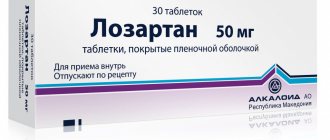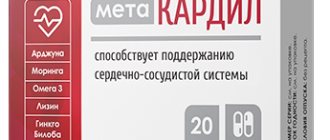Arterial hypertension is the most common cardiovascular pathology, affecting about 40% of the adult European population [1]. Of course, this leads to high demand for antihypertensive drugs, regardless of the season. And although the chief’s task is, first of all, to offer several drug options according to the INN prescribed in the prescription, he also has to explain side effects, dosage, and sometimes answer questions about the features of the mechanism of action. Therefore, we decided to offer our readers a series of articles about the group of antihypertensive drugs and the features of working with requests for them. Let's start with blockers of the renin-angiotensin-aldosterone system.
RAAS: the basics
Before we begin describing the drugs, let’s dive briefly into the intricacies of pharmacology and once again remember what the mechanism of action of the renin-angiotensin-aldosterone system, or RAAS, is.
The RAAS is a complex hormonal-enzymatic system in which almost all organs and tissues of the body are involved, but the key roles in it belong to the liver, kidneys, adrenal glands and lungs.
Alpha-2‑globulin angiotensinogen is constantly synthesized in the liver. At the same time, the kidneys produce the enzyme renin in response to decreased intrarenal pressure, decreased delivery of sodium and chloride, and hypoxia. It enters, like angiotensinogen, into the systemic circulation, where it binds to it to form angiotensin I.
Angiotensin I is a practically inert substance. It does not act on blood vessels and is only a precursor of the active component angiotensin II. In the formation of the latter, along with angiotensin I, angiotensin-converting enzyme (ACE), which is produced in the lungs, is involved.
Angiotensin II is the main link in the RAAS circuit.
It exhibits a powerful vasoconstrictor effect and affects the target organs in which its receptors are located. First of all, we are talking about the endothelium, heart and kidneys. This is why high levels of angiotensin II are associated not only with increased blood pressure, but also with damage to the vascular wall, myocardium, kidneys, and the development of chronic heart and kidney failure.
In addition, angiotensin II causes increased synthesis of the adrenal hormone aldosterone. The latter is involved in the control of blood pressure (BP) by regulating the homeostasis of potassium, sodium and intracellular fluid volume. Under its influence, blood pressure increases and the sensitivity of vascular smooth muscles to vasoconstrictor substances, including angiotensin II, increases.
Thus, the RAAS is directly involved in the drama called “arterial hypertension”, playing one of the main roles in it. Fortunately, it is possible to block this system. This can be done with drugs of two pharmacological groups - angiotensin-converting enzyme inhibitors (ACEIs) and angiotensin II receptor blockers (ARBs, also known as sartans).
About manufacturing companies
There are pharmaceutical companies that occupy leading positions in the production of new generation blood pressure medications. List of the most popular manufacturers of drugs for hypertension:
- "Servier" - France.
- Pfizer - USA.
- Abbott - USA.
- "Berlin-Chemie" - Germany.
- "Gedeon Richter" - Switzerland.
- "TEVA" - Israel.
- "KRKA" - Slovenia.
- "Egis" - Hungary.
- Farmak - Ukraine.
In fact, there are a lot of companies producing modern drugs to lower blood pressure. However, certain pharmaceutical manufacturers are particularly popular. They have won the trust of people thanks to the quality of their products and compliance with the latest trends in science. Constantly improving technology (the drug "Polipill") allows hypertensive patients to keep their blood pressure normal without taking a large number of pills. Such effective drugs are considered innovative.
Russian pharmaceutical companies do not lose popularity because they are little inferior to foreign competitors. The action of domestic antihypertensive drugs allows us to count on a good effect and a minimal number of adverse reactions. The cost of such drugs is much lower, which leads to widespread demand.
The first class of drugs is ACE inhibitors.
Drugs of this group became one of the first classes of drugs that effectively reduce the activity of the RAAS; their development began in the 60s of the last century [2]. Today they are included in the category of so-called “life-saving drugs” due to their proven ability to improve the prognosis of a number of cardiovascular and renal diseases [2].
ACE inhibitors: mechanism of action and effect
ACE inhibitors reduce the level of circulating angiotensin II by blocking the angiotensin-converting enzyme, which causes a complex pharmacological effect:
- antihypertensive;
- cardioprotective;
- angioprotective;
- antiatherosclerotic;
- anti-inflammatory.
When taking drugs from the ACE inhibitor group, carbohydrate metabolism also improves: tissue sensitivity to insulin increases and glucose metabolism improves.
Indications and properties
The spectrum of activity of ACE inhibitors allows their use in arterial hypertension, coronary heart disease, chronic heart failure, nephropathies and acute myocardial infarction [3].
ACE inhibitors belong to the group of antihypertensive drugs that specifically lower blood pressure and slow the progression of heart failure, which determines their widespread use in cardiology. Data from a review of 158,998 patients with hypertension showed that taking ACE inhibitors reduces mortality from all of the above causes. This is a significant advantage of ACE inhibitor drugs, including compared to angiotensin II blockers [4].
However, ACE inhibitors are still not able to completely prevent the conversion of angiotensin I to angiotensin II, since there are a number of other enzymes that successfully “replace” ACE. This is exactly how the enzymes chymase, elastase and cathepsin G work, for example [5]. When using ACE inhibitors, these substances are compensatory activated, and the blockade of the RAAS becomes incomplete. This is a significant drawback of ACE inhibitors.
What should I warn the client about?
Important!
During the consultation, it is appropriate to emphasize that drugs that block the activity of the RAAS - ACEIs and ARBs - with constant use, along with an antihypertensive effect, protect the heart and blood vessels, significantly reducing the incidence of cardiovascular accidents. This small note can serve as a convincing argument in favor of regular and disciplined use of such drugs, according to the instructions and recommendations of the doctor.
Indications for use
In addition to their main purpose, ACE inhibitors are aimed at protecting human internal organs. The active ingredients help the functioning of the blood pumping apparatus, kidneys, and blood vessels. In case of chronic renal failure, they help those suffering to restore health and feel better.
ACE inhibitors are used for the following indications:
- for hypertension;
- ischemic disease;
- atherosclerosis;
- kidney damage due to diabetes mellitus;
- chronic heart failure;
- heart attack;
- post-infarction state.
ACE inhibitors: remember by name
Let's consider the features of some drugs - representatives of the ACE inhibitor group.
- Captopril is the first non-peptide ACEI, synthesized in 1975 [2]. The only tableted ACEI used to relieve hypertensive crisis. The dose is prescribed by the doctor (12.5–50 mg).
- Lisinopril is the only hydrophilic ACEI that does not accumulate in adipose tissue. Therefore, it is recommended for hypertension against the background of excess body weight and metabolic syndrome [2].
- Ramipril is an ACE inhibitor, which in a randomized trial demonstrated a significant reduction in overall mortality from CVD in high-risk patients by 16%, mortality from myocardial infarction by 20%, from stroke by 32%, and from chronic heart failure by 23% [ 6]. In addition, the incidence of new cases of diabetes while taking ramipril was 33% lower than in the placebo group [7].
- Fosinopril is an ACE inhibitor that is suitable for patients with hypertension due to severe renal failure, since it is eliminated in two interchangeable ways: through the liver and kidneys.
- Enalapril is the only ACEI that has a parenteral form (the active metabolite of enalapril is enalaprilat). Enalaprilat, like captopril, is used to relieve hypertensive crisis.
- Zofenopril is one of the most lipophilic ACE inhibitors. Due to its high lipophilicity, it easily penetrates into organs and tissues, showing a special affinity for the heart and blood vessels. It has a long-term anti-ischemic and cardioprotective effect, and exhibits an antioxidant effect [8].
- Spirapril has a long half-life, which provides a long-lasting and uniform antihypertensive effect. Does not require dose titration [9].
- Quinapril has high tissue specificity - it suppresses ACE in the plasma, lungs, kidneys, heart, and vascular walls. Improves the function of the vascular endothelium, providing an antiatherosclerotic effect [10].
Classification and forms
ACE inhibitors are available in two types:
- drugs in active form;
- prodrugs are substances that become active after transformation in the gastrointestinal tract and kidneys.
Substances in this group are lipophilic, that is, they are eliminated through renal excretion (through the urinary system). For this reason, people with renal failure are recommended to start therapy with a reduced dosage of inhibitors. Among the inhibitors there are also hydrophilic drugs that are excreted in bile and feces.
ACE inhibitors, which are eliminated from the body through the liver, are considered the safest for long-term use. Drugs of the hydrophilic group are not metabolized in the body and are excreted in their original form, lipophilic inhibitors undergo partial metabolization and form organic substances, some of which are biologically active.
According to the duration of action, inhibitors are:
- short-acting, regular intake – 2-3 times a day;
- long-acting, regular use – 1-2 times a day.
Tolerability of ACE inhibitors
The subject of special attention of pervostolniks, as specialists dispensing the drug, is the side effects of ACE inhibitors. Despite the generally favorable safety profile, adverse reactions are the weak link of drugs in this group.
What should I warn the client about?
- While taking ACE inhibitors, a dry cough develops in 1–10% of cases [6]. Different members of the group practically do not differ from each other in their ability to cause it, and replacing one ACE inhibitor with another does not improve tolerability in this regard [11].
- When taking single-agent ACEIs, Quincke's edema can extremely rarely occur (but more often than when taking other antihypertensive drugs) [2]. It is believed that drugs in this group do not cause this complication, but alleviate its occurrence in predisposed patients. When releasing ACE inhibitors, it is appropriate to emphasize that if difficulty breathing and shortness of breath occur, you should immediately contact your doctor [11].
The cause of cough while taking ACE inhibitors has not been fully determined. It is assumed that the leading role is played by the accumulation of bradykinin in the bronchial mucosa, which is activated by blockade of angiotensin II [11].
The second class of drugs is angiotensin II receptor blockers.
Research that has focused on studying the possibilities of blocking the RAAS has led to the discovery of a group of drugs that do not have the classic disadvantage of ACE inhibitors - the side effect of cough. ARBs, or sartans, block the RAAS more completely, resulting in better tolerability than their predecessors. Despite their relatively recent introduction into clinical practice - sartans began to be used for long-term treatment of hypertension only in 1999 - representatives of this group have today become one of the most popular antihypertensive drugs [12].
Sartans: mechanism of action and effect
The pharmacological effect of sartans is identical to the effect of ACE inhibitors. Due to competitive blockade of angiotensin II receptors, they suppress vasoconstriction, aldosterone secretion, reduce myocardial hypertrophy, and also improve endothelial function.
The mechanism of action of ARBs is not the blockade of angiotensin-converting enzyme, as is the case with ACE inhibitors, but the blockade of angiotensin AT1 receptors, through which the vast majority of the physiological effects of angiotensin II are realized (vasoconstriction, etc.). AT1 receptors are located predominantly in vascular smooth muscle, heart, liver, adrenal cortex, kidneys, lungs and brain.
Over the past 10 years, drugs have appeared that some experts propose to separate into a separate, second generation of ARBs. They not only block AT1 receptors, but also help normalize carbohydrate and lipid metabolism.
Indications and properties
Sartans, like ACE inhibitors, are prescribed for a number of diseases, including arterial hypertension, chronic heart failure, previous myocardial infarction, diabetic nephropathy, atrial fibrillation and metabolic syndrome. In addition, ARBs become the drugs of choice in situations where cough develops while taking ACE inhibitors [13].
The effectiveness of sartans has been proven to significantly reduce blood pressure and have a cardioprotective effect [13, 14], as well as:
- reduce the incidence of myocardial infarction and stroke;
- reduce the frequency of hospitalizations due to chronic heart failure;
- reduce the severity of symptoms of CHF;
In addition, some ARBs, like ACEIs, reduce the likelihood of developing diabetes and exhibit nephroprotective effects.
Individual representatives of sartans
Most sartans have similar properties and differ little from each other both in pharmacokinetic parameters and in hypotensive and cardioprotective activity. But still, some ARBs have features:
- Losartan, the first synthesized sartan, has a uricosuric effect, that is, it increases the excretion of uric acid. Therefore, it is advisable to use it for concomitant gout [4].
- Valsartan blocks, along with AT1 receptors, AT2 receptors located in blood vessels. Due to the blockade of the latter, the drug has a vasodilating effect [13].
- Telmisartan increases tissue sensitivity to insulin and enhances glucose utilization in muscles and tissues. At the dosages used for the treatment of hypertension, the drug acts similarly to hypoglycemic drugs - thiazolidinedione derivatives (pioglitazone, rosiglitazone). It is this drug that some experts consider to be a representative of the second generation sartans [13].
- Azilsartan medoxomil is a new sartan that binds more tightly to AT1 receptors compared to other ARBs, due to which it has a powerful and long-lasting antihypertensive effect that is superior to the effect of other sartans. The drug increases tissue sensitivity to insulin and affects the mass of adipose tissue, reducing it. The drug is promising for patients with hypertension and metabolic disorders [14].
- Fimasartan is another new ARB inhibitor developed by a Korean company. It is used only as an antihypertensive agent [15].
Contraindications
In some cases, it is worth refraining from taking ACE inhibitors. Contraindications are:
- pregnancy and lactation;
- age under 18 years;
- intolerance to the components of the drug;
- kidney dysfunction;
- low pressure;
- narrowing of the aorta;
- excess potassium in the blood.
Caution should be exercised if there are pathologies such as hepatitis, cirrhosis, anemia, thrombocytopenia, agranulocytosis and low systolic pressure (below 90)











